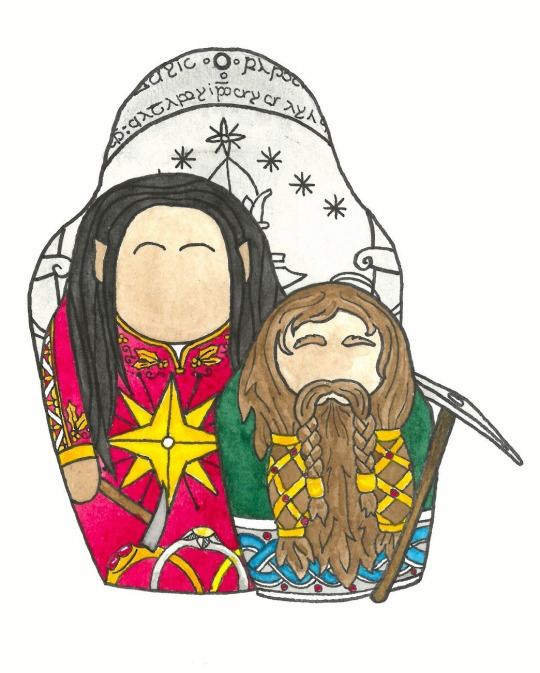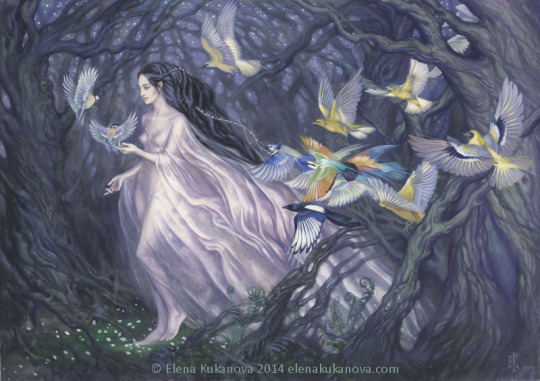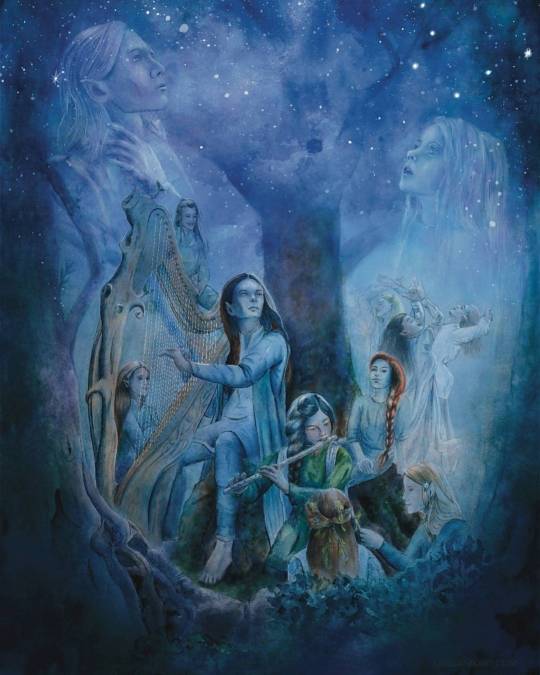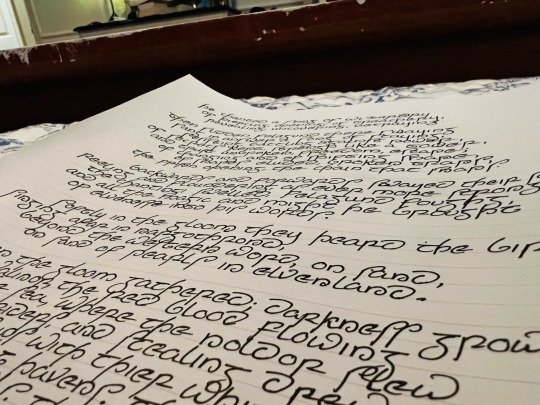#quendi
Text
Matryoshkha-inspired art for the SWG Meet & Greet Challenge

Doors of Durin, Celebrimbor, and Narvi. This was inspired by the collaborative nature of the challenge and was used as the banner art.
Ink and watercolor on paper.

Eol, Aredhel, and Maeglin (and his pet mole). This was for the International Fanworks stamp.
Ink and watercolor on paper.

To fit the Meet & Greet challenge, I picked some famous "meetings" out of the Silmarillion to depict. These were for the creator and comment stamps
In order of largest to smallest:
Thingol and Melian meeting in Nan Elmoth
Finrod finding the Beorians and playing to them as they slept
Oromë finding the awakened Elves at Cuivienen
Beren seeing Luthien dancing in Doriath
Ink and watercolor on paper
#artist: cuarthol#tolkien fanart#doors of durin#celebrimbor#narvi#eol#aredhel#maeglin#thingol#melian#finrod#edain#orome#quendi#luthien#beren#matryoshka dolls#silmarillion writers' guild
54 notes
·
View notes
Text

Eöl the dark elf by Soni Alcorn-Hender, 2016
#art#lotr#the silmarillion#silm art#silm#Silmarillion#tolkien#tolkien art#eöl#elf#elvish#quendi#eldar#watercolor#fanart#watercolour#the silm fandom#dark elf#maeglin#sauron#melkor#feanor#idril#Valinor#lord of the rings#jrr tolkien
67 notes
·
View notes
Photo

Water of Awakening
#art#Illustration#digital art#artists on tumblr#silmart#The Silmarillion#JRR Tolkien#elves#quendi#cuivienen
309 notes
·
View notes
Text

Her Magic Voice - by Elena Kukanova
"...in that time when the Quendi awoke beside the waters of Cuivienen she departed from Valinor and came to the Hither Lands, and there she filled the silence of Middle-earth before the dawn with her voice and the voices of her birds..."
Melian the Maia
illustration for the "Silmarillion" by Tolkien
gouache and watercolor on paper, 44x62cm
17 notes
·
View notes
Text
Elven Traits and Heredity
Foreword: The Beginnings of Life
This is part of a larger series of my meta/world building. Please see the masterlist linked to my pinned post to find additional entries.
In order to fully understand the nature of the development of Elven fëar and hroar, one must first know the ways in which the Firstborn and Secondborn differ in terms of physical and spiritual conception and development.
When a child of the Atani is conceived, it is first and foremost a biological process, and depends on cycles and chance. It might happen accidentally, or might not happen at all despite the partners’ efforts. When conception occurs, however, the spirit has not yet entered the body. Once the body is fully formed, a spirit then enters it that comes from outside the world, after which birth occurs. Thus, for the Secondborn, age is counted from the day of birth, and that day is celebrated as the beginning of life.
It is not so for the Firstborn. For the act of conception is an act of will and not dependent upon timing or chance. The spirit of an Elven child is formed first, a manifestation of their parents’ love for one another. Each parent contributes a portion of the energy of their own fëa, and these small portions combine form the beginning of a new spirit. Only after this fëa has been formed will physical conception occur, and the hröa begin to grow. During the pregnancy, both body and spirit are grown and nurtured by the parents, with the hröa being nurtured by the mother and the fëa by the father (this is reversed after birth). The spirit is within the body from the day of conception, and the begetting day is celebrated as the beginning of life and the age is counted from that day.
Thus, the spirits of the Elves are not wholly new, and made up of those of their parents that have grown and developed into their own separate entities. They are fully a part of Arda in that, aside from the Unbegotten, they originated within Arda, and remain therein forever, with each generation more tied to the world than the last. It is because of this as well that, as the generations go on, fewer children are born, and they are less mighty (save for those that dwelt in Valinor during the Years of the Trees) than those that came before, for there is some division of the life force of the Elves with each generation.
The spirits of Men are from beyond the world, and only enter the body when it is fully made, and so their spirits and their bodies, though closely joined while they dwell within Arda, are not made precisely to fit one another and parted more easily. The spirits of Men hold within them a desire to return to beyond the world, for they are but guests and visitors within Arda, and thus ultimately they will all depart, willingly or unwillingly.
It is this difference in spiritual origin and development that may account for many of the differences in the innate nature of the two peoples of the Eruhíni. There are many debates as to whether these processes are what cause the difference in the Fates of Elves and Men, or if it is because of the Fates that these differing processes occur. No scholar within Arda has yet to prove one or the other fully, leading to a third viewpoint— that none is directly because of the other, and that it is simply a part of the way that the world is. Many have elected to hold this viewpoint, particularly among the Quendi who had not come to a clear answer even after centuries of debate. The scholars of Men, however, frequently revive it once more in an attempt to find some new philosophy or evidence to answer it definitively. They have not as of yet been able to do so.
#silmarillion#tolkien#meta#elves#eldar#quendi#headcanon#expanded lore#elven traits and heredity#pregnancy tw
44 notes
·
View notes
Text
The Sundering of the Elves

"The Silmarillion" - J.R.R. Tolkien
#book quotes#the silmarillion#jrr tolkien#elves#sundering#quendi#eldar#avari#vanyar#noldor#teleri#calaquendi#sindar#nandor#laiquendi#umanyar#moriquendi
17 notes
·
View notes
Text
Having a moment about elves, their melancholy, and the inherent dissonance of placing immortal beings in a mortal world.
#I think it will always be strange to then and make them sad how middle earth changes and mortals die#It's both so unlike them!#Lothlorien: Galadriel's attempt to make something eternal in middle-earth. And it's an illusion too#tolkien#my posts#quendi#caveat on this is that it's a half-baked thought based on vibes.#the lord of the rings
9 notes
·
View notes
Text

Mereth Nuin Giliath by Kai-D-Janik on DeviantArt
3 notes
·
View notes
Text
They were valiant, but the history of those that returned to Middle-earth in exile was grievous; and though it was in far-off days crossed by the fate of the Fathers, their fate is not that of Men.
"The Lord of the Rings: Appendices – Appendix F" - J.R.R. Tolkien
#book quote#lotr#lord of the rings#jrr tolkien#appendices#appendix#quendi#elves#middle earth#exile#men
3 notes
·
View notes
Text


Still working on this one but practice is going well….
#calligraphy#finrod#finrod felagund#artists on tumblr#jrr tolkien#tolkien art#silmarillion art#high elves#tolkien#noldor#the love of writing#quendi#sauron#the lay of leithan#modified insular minuscule#noticed recently just how similar to Tengwar this is#I’ve done Carolingian minuscule before but hadn’t explored this for some reason
13 notes
·
View notes
Text
"Thus it was that when Nahar neighed and Orome indeed came among them, some of the Quendi hid themselves, and some fled and were lost" - Of the Coming of the Elves, The Silmarillion.
Shoutout to all the elves who saw Orome and ran so far so fast that literally no one ever saw them again.
#the silmarillion#years of the trees#orome#quendi#of the coming of the elves#judging by the previous few paragraphs#they were probably killed or captured by Morgoth's servants#but I'll ignore that for now#softlysilver
8 notes
·
View notes
Text
My hottest Tolkien take is that he should never have stopped calling them Gnomes.
#tolkien#Silmarillion#elves#quendi#let them be wretched litle creachures#all silmarillion art but everyone has a garden gnome pointy hat#tolkien was a coward for changing it and i do believe that
1 note
·
View note
Text
Ossë singing in front of Ulmo's salad so his new elves friends don't leave to Valinor is one of the many reasons I love him.
#ulmo: time to bring the quendi to safety in aman#ossë: how dare#ossë: i feel another villain era starting-#uinen: :) you what now ? :)#ossë: 😔 fine#no but seriously it lives in my head rent free#that he literally sung pleading for them to stay in middle earth#no one does it like him#ossë#gahhhh i miss writing him!!!!!!!!
9 notes
·
View notes
Text
Elven Traits and Heredity
I. Bodily Shape and Form
This is part of a larger series of my meta/world building. Please see the masterlist linked to my pinned post to find additional entries.
The body shape and structure of the Quendi vary widely— and these traits, unlike most, are determined partly by the inherited traits from their parents and partly by the nature and lifestyle of the individual as they grow. They may also be influenced by other factors within the individual’s life to some degree.
Shape, Size, and Build
As a general rule, the musculature of the Quendi is lean rather than bulky, and due to an overall higher metabolism, body fat percentage is lower than in other peoples. However, the body shape of an individual will vary greatly with their nature, as the hröa will grow to reflect the fëa.
The average, or “typical” Elven body depends on their craft, or their lifestyle— the warriors and some craftsmen will often have a more muscular and solid form, with broader shoulders and larger hands, while those that work in finer crafts will often have smaller hands and a slimmer or softer form. In such ways, where the Atani may take up activities or crafts which best suit their bodies, the Quendi are quite the opposite— as they discover their passions in their youth, their bodies will adapt to be optimized for the lifestyle they desire.
In addition to activity and passions, the shape and structure of the hröa can also be altered by one’s environment. Those who dwell in colder areas will have often have more body fat for insulation than those who have their homes in warmer regions. The geography of one’s home may also have an effect, and one’s foot shape may become better suited to walk on sand or to climb mountain cliffs, and those that dwell in the forest will be more flexible, while those that dwell in the grasslands are sturdier. If an adult Elf were to move to a different region, their hröa will also change to become more suited to its climate, at the same time as the fëa adapts.
The bodies of the Quendi do not become fixed when they reach adulthood— in fact, as maturity is reached when the fëa gains full mastery over the hröa, the adult Elf will have a greater physical adaptability than the child, who is still forming, and whose fëa is the greater focus of this development. The body shapes of Elven children have much less variance than those of adults, typically falling closely around the average.
It is very rare for an Elf to be exceptionally thin, as when the hröa is nourished properly, it will always trend toward a healthy-looking form. However, this may occur among those that have escaped captivity or other traumas and not yet fully recovered.
Height
The height of the Quendi can vary dramatically, from around five feet on the short end to nearly eight feet tall among the tallest of the Amanyar. Height is primarily inherited— a child will typically be somewhere between the heights of their parents. However, there are some exceptions to this.
The Amanyar, those that dwell or have dwelt in Valinor, are almost always taller than the Úmanyar, those that have never been to Aman. Even if one is born in Middle-Earth and later travels to Aman, they may also grow taller.
This was even more dramatic during the Years of the Trees, as those that lived under the light of the Trees were frequently about a foot taller than those who had not seen the light. Those that made the journey would also grow taller, but would not always reach the height of their children who were born under the light of the Trees. Later, in Beleriand as well as in Aman after the darkening, if both parents were Calaquendi, their child would inherit their height— but if only one parent had seen the tree-light, the child would likely be closer in height to their other parent. Not all Calaquendi were exceptionally tall, but most were— the average height was around six and a half to seven feet.
There were also a few individuals who grew to exceptional height, due to a close relationship with the Ainur. These individuals grew to around eight feet tall, with Thingol being the tallest of all of them at about eight and a half feet. While these few were exceptional, the overall increase in height among the Eldar was due almost completely to the presence and passive influence of Ainurin power.
The height of the Quendi is one of few aspects of the hröa that one’s gender can have an effect on, with the average height of the neri being around half a foot taller than that of the nissi.
Primarily, however, one’s height is determined by one’s ancestry. The Elves that awoke in Cuivienen were, at the time, all between five feet and six inches tall and six feet tall. The Calaquendi would eventually grow much taller, and the Moriquendi would become slightly shorter as time went on.
The Vanyar are the tallest of the Elves, though they only became such after dwelling beneath the Two Trees and living amongst the Ainur. The average height of the Vanyar is seven-and-a-half feet tall, and there is very little variance between genders in comparison to the other kindreds of the Amanyar.
The Ñoldor are not too much shorter than the Vanyar, but there is significantly more variance in height among them, with an average height of six feet and nine inches, but an average range in height from six and a half to seven feet.
The Falmari, those Teleri that crossed the sea under Olwë’s leadership, were near to the height of the Ñoldor, but with less variance, with an average height of six feet and seven inches.
As for the Moriquendi, there was even greater variance between peoples, but it was rare that one of them grew to be taller than seven feet. The Falathrim and the Sindar who dwelt outside of Doriath had an average height of six feet, while the Doriathrim were roughly two inches taller. The Nandor and Laiquendi were around five feet and eight inches tall. The heights of the Avari varied widely depending on which clan or tribe one belonged to, though they were typically a bit shorter than other kindreds with an average range of five feet and five inches to nearly six feet.
Facial Features
There is a great variety in the facial features of the Quendi, and each feature will be gone into in more detail in later entries. However, overall, the facial structures and features of the Quendi are often softer and somewhat more rounded than those of the Atani. While many Elven faces may tend toward the longer side, and may have a few sharper or pointier features, bony structures are often a bit less prominent than the average Man’s. Depending on the individuals, though, this may not be apparent, as there is significant crossover between the two peoples. The most distinguishing trait between Elves and Men, aside from their Presence and relationship with the world, would be ear shape.
Lack of Sexual Dimorphism
Because the Quendi do not have chromosomal sex, and gender is entirely of the fëa, there is no inherited physical dimorphism as there is in Men. Aside from height, which doesn’t always follow gender patterns, all body shapes and structures can be found in Elves of any gender. Facial hair is grown by those in their third cycle, regardless of gender, and breasts only take significant shape during the nursing of a child. During puberty, one’s gender will determine which reproductive organs develop fully, and may have some slight impact on the pitch of one’s voice, with the voices of the nissi sometimes being slightly higher than those of the neri, but other than that there is no physical difference. These things may also change later in life, if there is a shift in one’s gender identity or expression.
Because of this, there are also no sex-linked traits found in Elves, with all traits equally inheritable from both parents regardless of gender.
#silmarillion#tolkien#headcanon#elves#eldar#quendi#meta#expanded lore#elven traits and heredity#my writings#speculative biology
20 notes
·
View notes
Text
the feanorians would be all over speech act theory. after swearing that oath and all
#lotr#i mean like all quendi would be i suppose#but when your poorly thought out speech act challenges the theological underpinnings of your universe i think it takes on a new significanc#feanor in whichever afterlife you prefer: ok so what does this afterlife reveal about the nature of the universe and the limits of speech
3 notes
·
View notes
Text
"Paganity y La doña y sus cuentos: Quendi Hierofante - Debajo del incienso 'todo se inhala'"

Acampábamos entre cultivos colindantes, y de las desterradas figuras de aquellas zafras, curvaban con simpatía sus arañazos entre los escombros…
Se podía mirar con el rabillo del ojo, cuanto adoraban a las vacas y los ornamentos de carne o hueso. Honraban ideas, y sin embargo, en un acentuado ahora, precisamente en el año de nuestro señor; han concretado de adorar lo que sea que les procure fatiga de prosperidad espiritual. Abrir post»
Ilustración: Escena, por Quendi Hierofante
0 notes